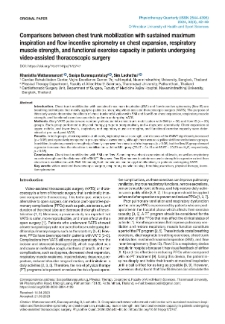Lower Silesian Digital Library contains 101 825 digital objects
Object
Title: Comparisons between chest trunk mobilization with sustained maximum inspiration and flow incentive spirometry on chest expansion, respiratory muscle strength, and functional exercise capacity in patients undergoing video-assisted thoracoscopic surgery
Creator:
Wattanananont, Khanistha ; Buranapuntalug, Sasipa ; Laohathai, Sira
Abstrakt:
Publisher:
Wydawnictwo Akademii Wychowania Fizycznego im. Polskich Olimpijczyków we Wrocławiu
Place of publication:
Date:
Resource Type:
Resource Identifier:
Language:
Relation:
Physiotherapy Quarterly ; Physiotherapy Quarterly,2024,vol.32,nr4
Rights:
Wszystkie prawa zastrzeżone (Copyright)
Access Rights:
Dla wszystkich zgodnie z licencją
License:
CC BY-NC-ND 4.0
Rights Owner:
Wydawnictwo Akademii Wychowania Fizycznego im. Polskich Olimpijczyków we Wrocławiu
Object collections:
- Lower Silesian Digital Library > Participants of the Consortium
- Lower Silesian Digital Library > Participants of the Consortium > 03. Wroclaw University of Health and Sport Sciences
- Lower Silesian Digital Library > Participants of the Consortium > 03. Wroclaw University of Health and Sport Sciences > Journals published at Wroclaw University of Health and Sport Sciences
- Lower Silesian Digital Library > Resources
- Lower Silesian Digital Library > Participants of the Consortium > 03. Wroclaw University of Health and Sport Sciences > Journals published at Wroclaw University of Health and Sport Sciences > Physiotherapy Quarterly
Last modified:
Feb 25, 2025
In our library since:
Feb 25, 2025
Number of object content hits:
1
All available object's versions:
https://dbc.wroc.pl./publication/170666
Show description in RDF format:
Show description in OAI-PMH format:
Similar
Botla, Afaf M. Ebrahim, Reham S. Elkosery, Soheir M. Darwesh, Ahmed M. Mohamed, Dina M.A.
Ahmed, Faruq Islam, Shofiqul Hassan, Nazmul Ahmed, Shahoriar Sultan Nahid, Zahid Bin Hoque Rase, Aminul
Jung, Michael Wilhelm Schubert, Patric Stephenson, Antonia Bader, Peter
























